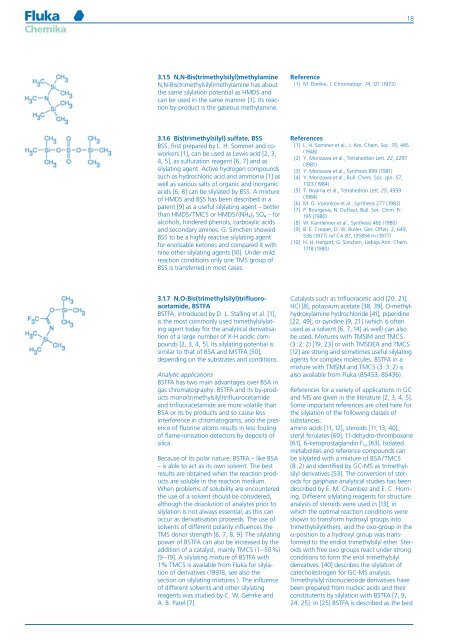Fluka - Sigma-Aldrich
Fluka - Sigma-Aldrich
Fluka - Sigma-Aldrich
You also want an ePaper? Increase the reach of your titles
YUMPU automatically turns print PDFs into web optimized ePapers that Google loves.
<strong>Fluka</strong><br />
Chemika<br />
3.1.5 N,N-Bis(trimethylsilyl)methylamine<br />
N,N-Bis(trimethylsilyl)methylamine has about<br />
the same silylation potential as HMDS and<br />
can be used in the same manner [1]. Its reaction<br />
by-product is the gaseous methylamine.<br />
3.1.6 Bis(trimethylsilyl) sulfate, BSS<br />
BSS, first prepared by L. H. Sommer and coworkers<br />
[1], can be used as Lewis acid [2, 3,<br />
4, 5], as sulfuration reagent [6, 7] and as<br />
silylating agent. Active hydrogen compounds<br />
such as hydrochloric acid and ammonia [1] as<br />
well as various salts of organic and inorganic<br />
acids [6, 8] can be silylated by BSS. A mixture<br />
of HMDS and BSS has been described in a<br />
patent [9] as a useful silylating agent – better<br />
than HMDS/TMCS or HMDS/(NH 4) 2 SO 4 – for<br />
alcohols, hindered phenols, carboxylic acids<br />
and secondary amines. G. Simchen showed<br />
BSS to be a highly reactive silylating agent<br />
for enolisable ketones and compared it with<br />
nine other silylating agents [10]. Under mild<br />
reaction conditions only one TMS group of<br />
BSS is transferred in most cases.<br />
3.1.7 N,O-Bis(trimethylsilyl)trifluoroacetamide,<br />
BSTFA<br />
BSTFA, introduced by D. L. Stalling et al. [1],<br />
is the most commonly used trimethylsilylating<br />
agent today for the analytical derivatisation<br />
of a large number of X-H acidic compounds<br />
[2, 3, 4, 5]. Its silylating potential is<br />
similar to that of BSA and MSTFA [50],<br />
depending on the substrates and conditions.<br />
Analytic applications<br />
BSTFA has two main advantages over BSA in<br />
gas chromatography: BSTFA and its by-products<br />
mono(trimethylsilyl)trifluorocetamide<br />
and trifluoracetamide are more volatile than<br />
BSA or its by products and so cause less<br />
interference in chromatograms; and the presence<br />
of fluorine atoms results in less fouling<br />
of flame-ionisation detectors by deposits of<br />
silica.<br />
Because of its polar nature, BSTFA – like BSA<br />
– is able to act as its own solvent. The best<br />
results are obtained when the reaction products<br />
are soluble in the reaction medium.<br />
When problems of solubility are encountered<br />
the use of a solvent should be considered,<br />
although the dissolution of analytes prior to<br />
silylation is not always essential, as this can<br />
occur as derivatisation proceeds. The use of<br />
solvents of different polarity influences the<br />
TMS donor strength [6, 7, 8, 9]. The silylating<br />
power of BSTFA can also be increased by the<br />
addition of a catalyst, mainly TMCS (1–50%)<br />
[9–19]. A silylating mixture of BSTFA with<br />
1% TMCS is available from <strong>Fluka</strong> for silylation<br />
of derivatives (19918, see also the<br />
section on silylating mixtures ). The influence<br />
of different solvents and other silylating<br />
reagents was studied by C. W. Gehrke and<br />
A. B. Patel [7].<br />
Reference<br />
[1] M. Donike, J. Chromatogr. 74, 121 (1972)<br />
References<br />
[1] L. H. Sommer et al., J. Am. Chem. Soc. 70, 445<br />
(1948)<br />
[2] Y. Morizawa et al., Tetrahedron Lett. 22, 2297<br />
(1981)<br />
[3] Y. Morizawa et al., Synthesis 899 (1981)<br />
[4] Y. Morizawa et al., Bull. Chem. Soc. Jpn. 57,<br />
1123 (1984)<br />
[5] T. Hiyama et al., Tetrahedron Lett. 25, 4959<br />
(1984)<br />
[6] M. G. Voronkov et al., Synthesis 277 (1982)<br />
[7] P. Bourgeois, N. Duffaut, Bull. Soc. Chim. Fr.<br />
195 (1980)<br />
[8] W. Kantlehner et al., Synthesis 460 (1980)<br />
[9] B. E. Cooper, D. W. Butler, Ger. Offen. 2, 649,<br />
536 (1977) ref CA 87, 135894 m (1977)<br />
[10] H. H. Hergott, G. Simchen, Liebigs Ann. Chem.<br />
1718 (1980)<br />
18<br />
Catalysts such as trifluoracetic acid [20, 21],<br />
HCl [8], potassium acetate [38, 39], O-methylhydroxylamine<br />
hydrochloride [41], piperidine<br />
[22, 49], or pyridine [9, 21] (which is often<br />
used as a solvent [6, 7, 14] as well) can also<br />
be used. Mixtures with TMSIM and TMCS<br />
(3:2:2) [19, 23] or with TMSDEA and TMCS<br />
[12] are strong and sometimes useful silylating<br />
agents for complex molecules. BSTFA in a<br />
mixture with TMSIM and TMCS (3:3:2) is<br />
also available from <strong>Fluka</strong> (85433, 85436).<br />
References for a variety of applications in GC<br />
and MS are given in the literature [2, 3, 4, 5].<br />
Some important references are cited here for<br />
the silylation of the following classes of<br />
substances:<br />
amino acids [11, 12], steroids [11, 13, 40],<br />
steryl ferulates [60], 11-dehydro-thromboxane<br />
[61], 6-ketoprostaglandin F 1� [63]. Isolated<br />
metabolites and reference compounds can<br />
be silylated with a mixture of BSA/TMCS<br />
(8:2) and identified by GC-MS as trimethylsilyl<br />
derivatives [53]. The conversion of steroids<br />
for gasphase analytical studies has been<br />
described by E. M. Chambez and E. C. Horning.<br />
Different silylating reagents for structure<br />
analysis of steroids were used in [13], in<br />
which the optimal reaction conditions were<br />
shown to transform hydroxyl groups into<br />
trimethylsilylethers, and the oxo-group in the<br />
�-position to a hydroxyl group was transformed<br />
to the endiol trimethylsilyl ether. Steroids<br />
with free oxo groups react under strong<br />
conditions to form the enol trimethylsilyl<br />
derivatives. [40] describes the silylation of<br />
catecholestrogen for GC-MS analysis.<br />
Trimethylsilyl ribonucleoside derivatives have<br />
been prepared from nucleic acids and their<br />
constitutents by silylation with BSTFA [7, 9,<br />
24, 25]. In [25] BSTFA is described as the best

















